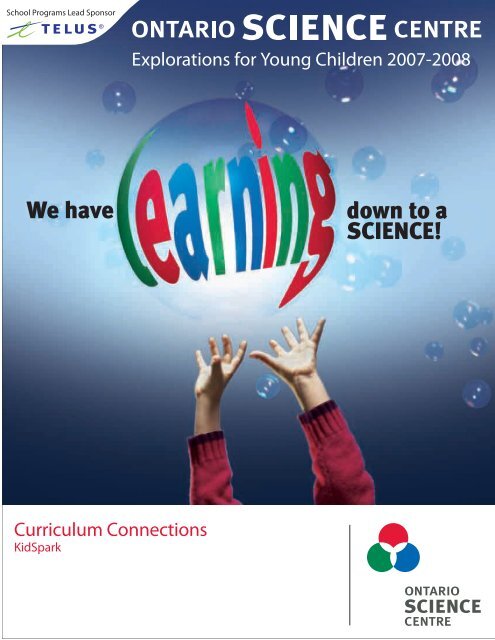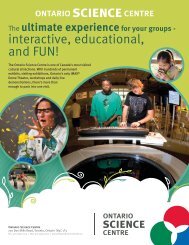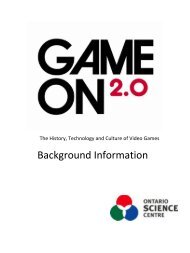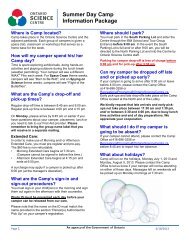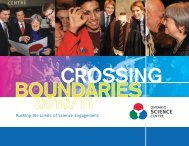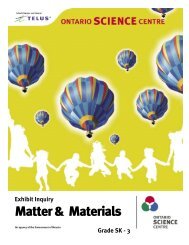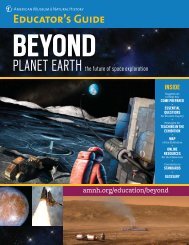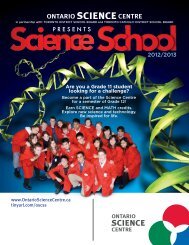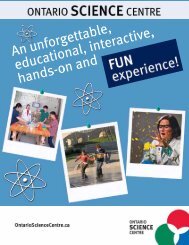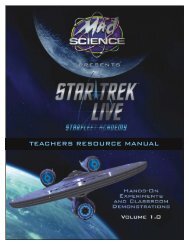Download KidSpark Curriculum Connections - Ontario Science Centre
Download KidSpark Curriculum Connections - Ontario Science Centre
Download KidSpark Curriculum Connections - Ontario Science Centre
Create successful ePaper yourself
Turn your PDF publications into a flip-book with our unique Google optimized e-Paper software.
School Programs Lead SponsorExplorations for Young Children 2007-2008We havedown to aSCIENCE!<strong>Curriculum</strong> <strong>Connections</strong><strong>KidSpark</strong>
<strong>KidSpark</strong>Agents of Change is an initiative that transformed more than 30 percent of the <strong>Ontario</strong> <strong>Science</strong> <strong>Centre</strong>'spublic spaces and created new large-scale outdoor experiences. New experience areas will awaken anddevelop the attitudes, skills and behaviours that foster innovation. Of special interest to teachers ofprimary students, <strong>KidSpark</strong> was the first new experience area under Agents of Change and opened inNovember 2003.<strong>KidSpark</strong> is a large, stimulating, learn-through-play space designed to foster creativity and earlyinnovation skills in students preschool to Grade 3. Comprised of open-ended interactive experiencesgrouped into themes, <strong>KidSpark</strong> will give young students a sense of empowerment and demonstrate thatscience is filled with wonder, experimentation and discovery. Within each themed area, students will findsuch inspiring spaces as a mini-music studio, a water play area and a kid-size construction site wherethey can explore science while having hands-on fun!<strong>Ontario</strong> <strong>Science</strong> <strong>Centre</strong> and Early Childhood Education facilitators will be on hand in <strong>KidSpark</strong> toprovide encouragement to students and their supervisors engaged in these informal learningexperiences. Formal curriculum-correlated programs for school children in Junior Kindergarten to Grade3 can be delivered in two enclosed Primary Workshop spaces adjacent to <strong>KidSpark</strong>. The <strong>Ontario</strong><strong>Science</strong> <strong>Centre</strong> science educators present the following fun, educational and interactive hands-onprograms:• Adventures in <strong>Science</strong> (JK-SK)• <strong>Science</strong> Investigators (JK-SK)• Energy (SK-3)• Matter and Materials (SK-3)• Living Things and the Environment (SK-3)• Structures (SK-3)• The Night Sky (SK-3)• Tinkering with Technology (SK-3)Support for <strong>KidSpark</strong> has been generously provided by Lead Partners: The W. Garfield WestonFoundation, the Government of <strong>Ontario</strong>, TELUS, DuPont Canada and the Department of CanadianHeritage - with additional support from <strong>Ontario</strong> Early Years Challenge Fund, Imperial Oil Foundation andThe Frum Foundation.School visits to the <strong>Ontario</strong> <strong>Science</strong> <strong>Centre</strong> and these educational programs can be booked by visitingour website at www.<strong>Ontario</strong><strong>Science</strong><strong>Centre</strong>.ca
DETAILED CURRICULUM CONNECTIONS<strong>KidSpark</strong> experiences build on expectations from The <strong>Ontario</strong> <strong>Science</strong> and Technology <strong>Curriculum</strong>, assummarized below. These highly motivating experiences, supported by <strong>Ontario</strong> <strong>Science</strong> <strong>Centre</strong> and EarlyChildhood Education facilitators, will help students:• understand the basic concepts of science and technology• develop the skills, strategies, and habits of mind required for scientific inquiry and technological design• relate scientific and technological knowledge to each other and to the world outside the school(●) bullets refer to the <strong>Curriculum</strong> expectationsGrade AreaK <strong>Science</strong> and Technology• pose questions and make predictions and observations before and during investigations• select and use materials to carry out their own explorations, and communicate their intentions• communicate results and findings from individual and group investigations• investigate, in various ways, how different forces make things move• demonstrate an awareness of local natural habitats through exploration and observation• investigate various materials that have different properties by manipulating and comparing themsafely in individual and small-group explorations, and describe their observations• experiment with simple machines and common objects, and describe their investigations• investigate and use familiar technological items, and describe their use in daily life• solve problems while designing and constructing things, using a range of tools, materials, andtechniquesSTRAND - Life SystemsGrade Topic1 Characteristics and Needs of Living Things• identify major parts of the human body and describe their functions• identify and describe common characteristics of humans and other animals that they haveobserved, and identify variations in these characteristics• select and use appropriate tools to increase their capacity to observe• ask questions about and identify some needs of living things, and explore possible answers tothese questions and ways of meeting these needs• plan investigations to answer some of these questions or find ways of meeting these needs• identify a familiar animal or plant from seeing only a part of it• describe a balanced diet using the four basic food groups outlined in Canada’s Food Guide toHealthy Eating, and demonstrate awareness of the natural sources of items in the food groupsSTRAND - Structures and MechanismsGrade Topic1 Everyday Structures• ask questions about and identify needs or problems related to structures in their immediateenvironment, and explore possible answers and solutions• plan investigations to answer some of these questions or solve some of these problems• explain the function of a structure that they have made and describe how they made it• identify the action (input) required to operate an everyday system, and identify the response(output) of that system• identify ways in which various structures are similar to, and different from, others in form andfunction• identify geometric shapes in ordinary structures• design and make different structures using concrete materials, and explain the function of thestructure• distinguish between structures and devices made by humans and structures found in nature
STRAND - Matter and MaterialsGrade Topic1 Characteristics of Objects and Properties of Materials• describe various materials using information gathered by using their senses• demonstrate ways in which various materials can be manipulated to produce different soundsSTRAND - Earth and Space SystemsGrade Topic1 Daily and Seasonal Cycles• investigate changes that occur in a daily cycle and in a seasonal cycle• demonstrate an understanding of changes that occur in daily and seasonal cycles and of how thesechanges affect the characteristics, behaviour, and location of living thingsSTRAND - Energy and ControlGrade Topic1 Energy in Our Lives• identify food as a source of energy for themselves and other living things• operate a simple device or system and identify the input and outputSTRAND - Life SystemsGrade Topic2 Growth and Changes in Animals• demonstrate an understanding of the similarities and differences among various types of animalsand the ways in which animals adapt to different environmental conditions• identify and describe the major physical characteristics of different types of animals• compare ways in which animals eat their food, move, and use their environment to meet theirneeds• describe ways in which animals respond and adapt to their environmentSTRAND - Matter and MaterialsGrade Topic2 Properties of Liquids and Solids• identify, through observation, various substances that are buoyant, that can absorb anothersubstance• identify objects in the immediate environment as solids or liquidsSTRAND - Earth and Space SystemsGrade Topic2 Air and Water in the Environment• describe the movement of air relying on their observations of its effectsSTRAND - Energy and ControlGrade Topic2 Energy from Wind and Moving Water• demonstrate an understanding of the movement of air and of water as sources of energy• design and construct a device propelled by air• design and construct a system that controls the flow of water and/or air using a variety ofmechanisms• describe how gravity and the shape of different structures affect the behaviour and use of movingwaterSTRAND - Structures and MechanismsGrade Topic2 Movement• identify changes in the position of an object in relation to other objects
• describe, using their observations, the effects of changing the slope of an inclined plane on themotion of an object that is placed on it• ask questions about and identify needs or problems related to structures and mechanisms, andexplore possible answers and solutions• plan investigations to answer some of these questions or solve some of these problems, anddescribe the steps involvedSTRAND - Energy and ControlGrade Topic3 Forces and Movement• investigate the ways in which different forces can change the speed or direction of a moving object• identify, through observation, different forms of energy and suggest how they might be used toprovide power to devices and to create movement• design and construct a device that uses a specific form of energy in order to moveSTRAND - Structures and MechanismsGrade Topic3 Stability• describe ways in which forces alter the shape or strength of different structures• describe the effects of different forces on specific structures and mechanisms• ask questions about and identify needs and problems related to structures and mechanisms in theirimmediate environment, and explore possible answers and solutions• plan investigations to answer some of these questions or solve some of these problems, andexplain the steps involvedSTRAND - Matter and MaterialsGrade Topic3 Magnetic and Charged Materials• design and construct a system that uses magnetic force to move an object


